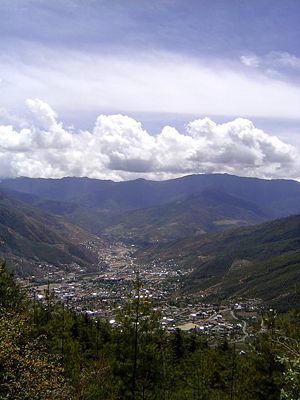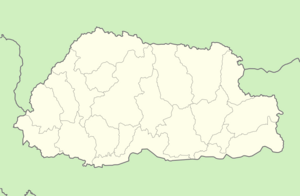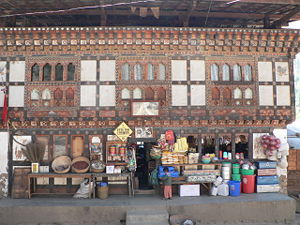Thimphu
| Thimphu | |
 |
|
 Thimphu
|
|
| Coordinates: | |
| Country | |
|---|---|
| District | Thimphu District |
| Elevation | 7,656 ft (2,320 m) |
| Population (2005) | |
| - Total | 98,676 |
Thimphu (Tibetan script: ཐིམ་ཕུག།) is the capital of Bhutan, and also the name of the surrounding valley and dzongkhag, the Thimphu District. With a population of 98,676 (2005 PHCB), it is the largest population centre in the country. Thimphu is located at , altitude of 2320m/7656ft.
Contents |
Overview
Thimpu became a town in 1961 and grew as the capital of Bhutan. Before 1960, Thimpu was a small settlement but was developed by the King Jigme Dorje Wangchuk to replace the ancient capital of Punakha.
Today the city sprawls across the western slopes of the Wang Chhu river valley, with several government offices located around Tashichoe dzong.
Rapid expansion following the pattern of rural exodus has resulted in considerable rebuilding in the city centre and mushrooming suburban development elsewhere. Norzin Lam, the recently upgraded main thoroughfare, is lined with shops, restaurants, retail arcades and public buildings.
Elsewhere, there is a mix of apartment blocks, small family homes and family-owned stores. By regulation, all buildings are required to be designed in traditional style with Buddhist paintings and motifs. A lively weekend market near the river supplies meat, vegetables and tourist items. Most of the city's limited light industry is located south of the main bridge. Thimphu has a growing number of commercial services and offices which provide for ever-growing local needs. With on going preparations for the 2008 celebrations of 100 years of Monarchy and Bhutan's transition to Parliamentary Democracy, numerous construction projects are visible throughout the city.
Dechen Phrodrang Monastery, Tango Monastery, Cheri Monastery and Dechencholing Palace, the official residence of the King, are located to the north of the city.
Climate
| Month | Jan | Feb | Mar | Apr | May | Jun | Jul | Aug | Sep | Oct | Nov | Dec | |
|---|---|---|---|---|---|---|---|---|---|---|---|---|---|
| Average high °C | 12,3 | 14,4 | 16,4 | 20 | 22,5 | 24,4 | 18,9 | 25 | 23,1 | 21,9 | 17,9 | 14,5 | |
| Average low °C | -2,6 | 0,6 | 3,9 | 7,1 | 13,1 | 15,2 | 13,4 | 15,8 | 15 | 10,4 | 5 | -1,1 | |
| Source: [1] | |||||||||||||
Public transport
Thimphu is served by a 'City Bus' service which operates throughout the day. Plans have also been made to construct a light tram along the banks of the Wang Chhu that is both environment-friendly and efficient.
Landmarks in Thimphu

Tashichoedzong hosts a colourful masked-dance festival (tsechhu) at the end of summer, which is popular with tourists. A new Tsechhu ground which can take in the capacity of both tourists and the locals is under construction and is expected to be completed by June 2008.
Thimphu is one of two national capitals in Asia that does not have traffic lights (the other is Pyongyang, North Korea). Local authorities had installed a set of lights but before they became operational the lights were removed. Instead of traffic lights, the city takes pride in its traffic police that directs the oncoming traffic with their dance-like movement of their arms and hands.
The Memorial Chorten dominates the skyline of Thimphu. This Chorten is dedicated to the Third Druk Gyalpo (King), Jigme Dorji Wangchuck after his sudden death while travelling abroad. A great amount of renovation is taking place for the 2008 celebrations to mark the Century of the Monarchy in Bhutan.
The National Library (1967) built in the style of a traditional temple contains a large collection of religious books and manuscripts in Dzongkha and Classical Tibetan and a collection of English-language books. It also contains a copy of the largest published book in the world.

The Buddha Dordenma statue, the largest Buddha statue in the world, is under construction on a mountain top called Kuensel Phodrang, overlooking the city. The statue will be finished in 2008.
The National Post Office, along Chang lam, is an institute itself where famous Bhutanese export is seen and sold: the various stamps. Stamp collectors all over the world know that Bhutan is the first country to diversify and export quality stamps. Old and expensive stamps are exhibited at the National Museum in Paro.
The Clock Tower Square is a recently renovated square surrounded by shops and restaurants. Fountains and traditional Bhutanese Mani Lhalhor (prayer wheels) make the place more comfortable. On one side, the luxurious Druk Hotel is situated. Various programmes and activities are held here. It was also the check point for the SAARC Car Rally.
Museums

Along the end of the Norzin Lam(Lam - road/street), Thimphu's own Textile Museum that displays various Bhutanese textiles that are extensive and rich in traditional culture. It also exhibits colourful and rare kiras and ghos (traditional Bhutanese dress, kira for women and gho for men).
The National Folk Heritage Museum displays traditional Bhutanese ways of life in a traditional Bhutanese house. It is an interesting view in to Bhutanese culture and domestic lives of the Bhutanese. There are also Bhutanese dances and exhibits held in the Museum Compound.
VAST (Voluntary Artist's Studio, Thimphu) located along Chang Lam is a busy place with after-school and weekend drawing and painting classes for youngsters conducted by volunteer artists. A gallery on the top floor exhibits a mixture of both traditional and contemporary works. There is also a small library and coffee shop where budding artists are encouraged to meet.
The National Institute of traditional Medicine has also a small museum on its premises.
Every monastery and temple in Thimphu is alive and well. These are some institutions where one can see how Buddhists pray and their daily routines.
Institutions

Thimphu is the center for various educational institutions:
The city is the home for the office of the [[Royal University of Bhutan] (Commonly known as the RUB). Some of the member colleges of RUB which are also located in Thimphu are:
- The Institute for Language and Culture Studies (ILCS) provide training to undergraduate students in national language, culture and traditions of Bhutan.
- The National Institute of Traditional Medicine (Estb. 1988) contains an impressive, large laboratory and production facilities that ensures quality of the products, the components of which includes plants, minerals, animal parts, precious metals and gems. The Institution produces traditional Bhutanese medicine towards the needs of the public. There is a day-care facility and clinic where doctors diagnose patients and prescribe appropriate medicines or treatments. The institute also researches the use of herbs and plants and has a plot(trial) on the premises. A small museum and a gift shop(where the famous herbal tea -Tsheringma- is produced) is also present in its compounds.
- [Royal Institute of Health Sciences] (RIHS)provides training to nurses and technician.
- [Royal Institute of Management] (RIM) provides training in administrative and financial management to mid-level manager.

The National Institute for Zorig Chusum is a training institute that trains students in the thirteen traditional arts known as the Zorig Chusum. Many visitors take time to look at the works and arts and even watch how a piece is made.
The Royal Academy of Performing Arts (RAPA) is the home of the Royal Dance troupe.
Thimphu Structure Plan

A new plan for the city, called the Thimphu Structure Plan (TSP)[2] , was prepared and approved by the Council of Ministers in 2003, and subsequently by the elected Thimphu Municipal Corporation, that is implementing the plan. The TSP was prepared by the well-known architect Christopher Charles Benninger, who won the American Institute of Architect's Award 2000 for his design of the United World College of India and the Great Master's Award 2007 for his contribution to architecture. In 2006 the British Society for Design made him the first Indian Architect to receive the Recognition of Excellence Award. In 2007 he became the sixth Indian Architect to win the Golden Architect Award for Life Time Achievement. He has recently won the Indian Institute of Architect's Award for the Best Institutional building in India (2006).

The TSP is directed at protecting the fragile ecology of the valley, including its rivers and forests. Considering the rapid growth of automobiles and pressure on the public health infrastructure in the town centre, restrictions on plot coverage and building heights were imposed. Critical to the plan are fifteen Urban Villages created through participatory land pooling, each having its own Village Square with amenities, garden, creche and an express bus link connected by the proposed Urban Corridor (under construction). The planning approach became widely known as the Principles of Intelligent Urbanism.
Challenges facing the TSP from large land owners were and remain considerable. Participatory public consultations and meetings with Stakeholders were held, integrating the concerns of local inhabitants. The World Bank and the Asian Development Bank are funding the plan, which is visibly improving the city. Planners and urban managers from other countries are visiting the Kingdom to learn how an urban fabric can be well managed with limited funds. The Structure Plan is noteworthy for its participatory approach in which there were city wide consultations and grass root meetings with the local land owners. The plan was given a dedicated web page by the government so that it could be downloaded in its entirety by anyone wishing to analyse it. Unlike many other such plans in the sub-continent, this plan is rapidly being implemented.
See also
- Punakha, the former capital of Bhutan.
References
External links
- Thimphu on Bhutannica
- Thimphu on Wikitravel
- Department of Tourism, Bhutan
- City map RAO online
- Thimphu Dzongkhag
- Five year plan 2002-2007
- The Thimphu Classifieds
- Thimphu City Information and Pictures
|
|||||||||||||||||